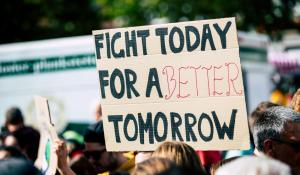
In any given month, white Americans save and invest hundreds of dollars more into their accounts than their Black counterparts—76% more, to be exact. This information comes from the 2020 Ariel-Schwab Black Investor Survey (Ariel is a Black-owned investing company), highlighting the discrepancies faced by Black Americans when it comes to financial equity.
Investing remains exclusive, painting a more somber financial reality for Black Americans.
Leaders, activists, and progressive institutions, however, continue to fight for financial equity and the undoing of centuries of financial exclusion.
Access: Financial Inequity, For Centuries
Calvin Holmes, president of the Chicago Community Loan Fund {GBN}, sees racism and white supremacy at play in financial barriers, from a lack of workplace promotions and discrimination in the American education system, preventing Black Americans from a more lucrative resume.
“American history is full of examples of violent white supremacists stripping or blocking BIPOC [Black, Indigenous, and People of Color] wealth building,” Holmes states.
He offers the example of the 1921 Tulsa Massacre and Viola Fletcher, who was seven when a white mob destroyed everything her family built. At the time, Tulsa’s affluent Black community, the Greenwood District, was known as “Black Wall Street.” White people in the area were resentful of their Black neighbors’ wealth and success. In the Massacre, white mobs burned the entire district, including churches, schools, a hospital, a library, and over 1,200 homes. Over 800 people were injured and as many as 300 died.
“She had never made enough money thereafter to cover her basic needs,” Holmes explains of Fletcher’s life following the Tulsa Massacre. “She instead was left to a penniless life of working as a domestic servant for whites.”
In 2021, a century later, Fletcher testified before Congress for the right to reparations.
Reparations, a system of remedies for egregious injustices, is the least the US owes to Black Americans for the enduring generational trauma of slavery and intentional financial inequity. The Land Back movement for Indigenous peoples, which you can read more about on p. 16, is a form of reparations, as was the 3.45 billion Deutsche Marks West Germany agreed to pay Holocaust survivors in 1952. But no reparations have been paid to Black Americans, intentionally keeping wealth-building opportunities from them and staying in line with a system that was built by and for white people.
“The financial services industry has a history of systemic racism, with systems to legally discriminate against Black Americans,” says Teri Williams, president and chief operating officer of OneUnited Bank. “From slavery to Jim Crow to redlining to predatory lending, changes in public policy are needed to reverse systemic racism and help Black Americans build wealth today.”
Investing and the Racial Wealth Gap
New technologies, apps, and companies are making investing easier for everyone, notes Williams. She cites things like “keep the change” apps, which round up payments and divert the extra to your savings. Another solution is automatic 401(k) enrollment, which should become easier since Congress passed the Secure Act 2.0 in March 2022, mandating employers enroll employees in the 401(k) program.
“From slavery to Jim Crow to redlining to predatory lending, changes in public policy are needed to reverse systemic racism and help Black Americans build wealth today.”
—Teri Williams, OneUnited Bank
“Corporations and government must continue to do more to hire lower-wealth Black and brown people into their highest paying jobs,” Holmes says. “They must diversify their cabinets and boards to help their operations generate more racial economic equity and thus create more wealth for non-white people to invest.”
Creating more wealth is crucial—especially while the racial wealth gap continues to exist. During the pandemic, about twice as many Black Americans than white had to borrow from their retirement savings and dip into emergency funds, according to the Ariel-Schwab survey.
Black Americans also continue to make less than their white counterparts, according to the Society for Human Resource Management, and hold 2.9% of the overall wealth in the country, compared to white Americans possessing 86.8% of wealth, according to the Federal Reserve.
Tools for Fighting Inequity
COVID-19 was a sobering reality for everyone. According to the survey, on 2020, Black Americans cut spending, put money into savings and investing accounts, and checked investment performance at higher rates than white Americans. This, combined with more recent financial optimism, led Black families to talk more about investing (27% compared to 18% of white families). Now younger generations of Black Americans are investing at higher rates and need to be supported.
“We believe in defining the Black community by our assets rather than our challenges, including the $1.3 trillion we spend annually,” offers Williams.
As outlined on the OneUnited website, one asset-focused strategy for closing the racial gap is prioritizing one of six transactions: savings & investments; profitable business; improved credit scores; home ownership; creating a will; insurance.
“All six strategic transactions are the cornerstones to building generational wealth, but we recommend each family choose one that is either the easiest to accomplish or creates the most economic reward,” Williams says. “Once you learn the steps necessary to accomplish your goal, your learning will become actionable rather than academic.”
Holmes also shares how the power of the internet has broken down many barriers for financial literacy.
Williams wants to see outreach work to Black communities, like that of DREAM and BlackFem.
Changing the Narrative
Tools, though, are not enough to create enduring change—and let white-dominated institutions off the hook. We must change the way society sees and the government acts on wealth equity, white supremacy, and systemic oppression.
“Government agencies, charitable foundations, and corporations often work in concert to stigmatize Black Americans to attract resources to address the problems they name,” Williams condemns. “They fail to realize that in doing so, they succeed at writing Black Americans into the public’s mind as a problem to be solved and a threat to be mitigated rather than aspiring and contributing human beings.”
This narrative must be changed for true economic justice and equity, Williams says.
A reimagined world where Black people can invest and grow wealth equitably has huge potential to improve individual lives and grow the green economy. It’s what’s required for true economic justice and equity, concludes Williams.
According to a 2021 report from the Proceedings of the National Academy of Sciences, people with incomes of $80,000 a year report more happiness and confidence in weathering negative events than those making less. Unsurprisingly, when people have enough money to cover bills, unexpected events, have fun experiences, and higher quality of life, they are happier. Investing can be one step toward that goal.
A 2022 update to the Ariel-Schwab survey found that Black investors are 15% more likely to align their investments with their personal beliefs than white investors, and more likely to prioritize socially responsible investing (SRI). The Black financial leaders highlighted on p. 10 show examples of how that might be done with Black American’s collective $1 trillion in buying power. Prioritizing and improving Black Americans’ wealth, as well as their education and access to investing, will increase the power of SRI investing, and green our economy.
Simply put: it’s important to make investing equitable for Black Americans because it is what they are owed, and also because Black investors will add to the strength of the society and a healthy planet. ✺







